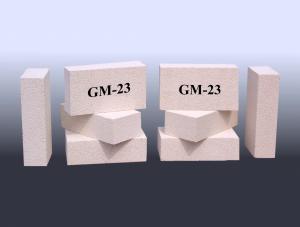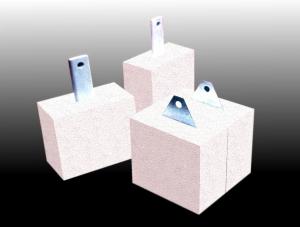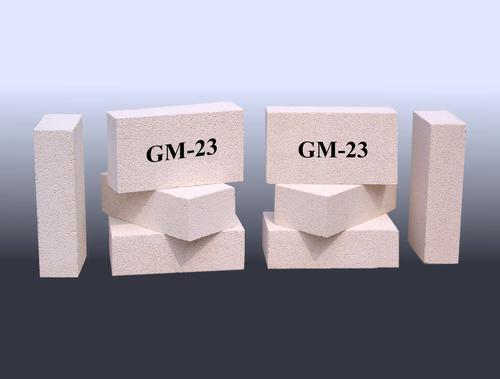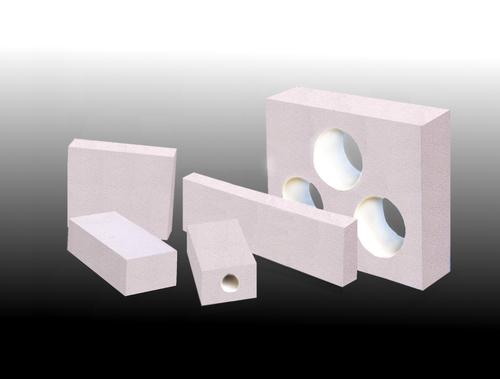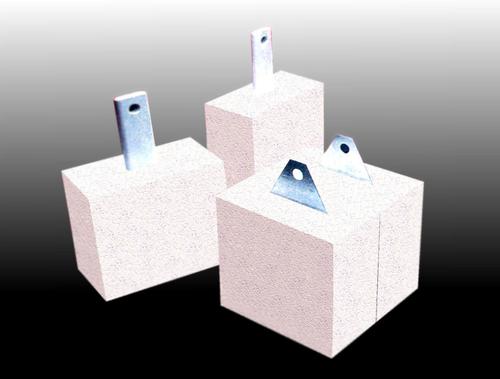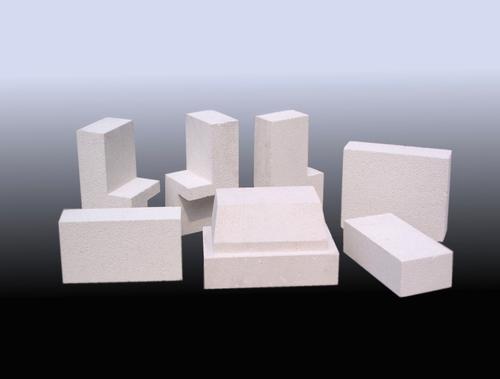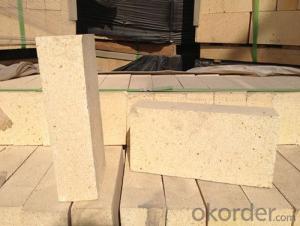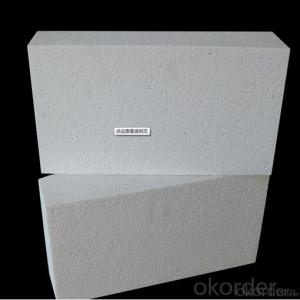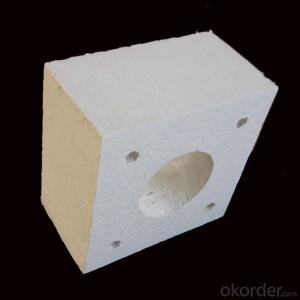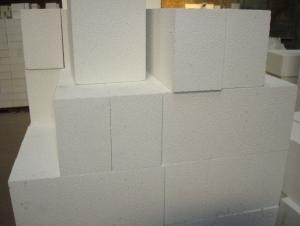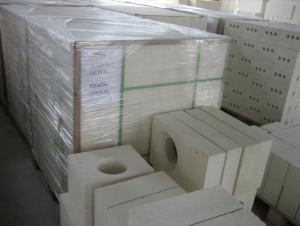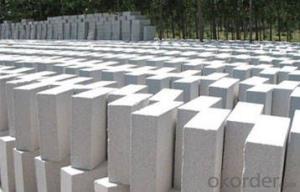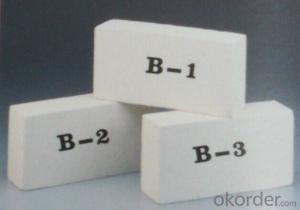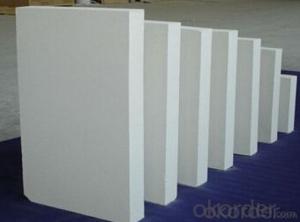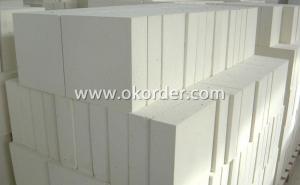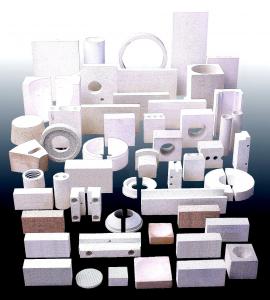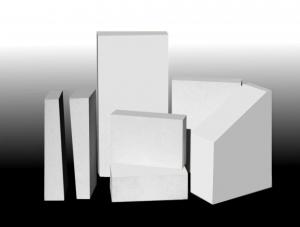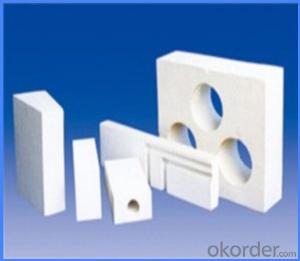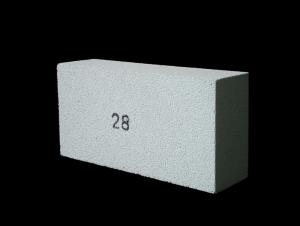Insulating Fire Brick - Refractory Insulating Fire Brick Code GJM23
- Loading Port:
- Shanghai
- Payment Terms:
- TT OR LC
- Min Order Qty:
- 10 m.t.
- Supply Capability:
- 30000 m.t./month
OKorder Service Pledge
OKorder Financial Service
You Might Also Like
General Information
CMAX insulating firebricks are classified under temperature between 1300℃ to 1700℃, manufactured from high purity alumina clay.
1. Lower content of iron, alkaline and impurities, good high temperature properties.
2. Homogeneous structure, light weight, energy saving because lower heat storage in the furnace during cooling cycles.
3. High strength, good thermal shock resistance under high temperature.
4. Precise sizes due to grinding and shaping after sintering, which meets the requirement of construction.
5. Max service temp: Up to 1730C (3160F)
Feature
Light weight and low thermal conductivity
Low heat storage
Low iron and impurities
High thermal shock resistance
Application
CMAX insulating firebricks can be used as a hot face lining directly exposed to the heat or as a backup insulation layer in iron and steel mills, non-ferrous foundries, petrochemical, ceramic, glass.
Technical Data
ITEM | GJM30 | GJM28 | GJM26 | GJM23 |
Classification Temperature, ℉/℃ | 3000/1650 | 2800/1540 | 2600/1430 | 2300/1260 |
Bulk Density,g/cm³ | ≤1.0 | ≤0.9 | ≤0.8 | ≥0.5 |
Reheating Linear Change, % | ≤0.9 (1550℃,12 h) | ≤0.8 (1510℃,12 h) | ≤0.7 (1410℃,12 h) | ≤0.5 (1230℃,12 h) |
Al2O3 Content, % | ≥75 | ≥65 | ≥55 | ≥45 |
Fe2O3 Content, % | ≤0.5 | ≤0.6 | ≤0.7 | ≤1.0 |
Thermal Conductivity: | ||||
800℃, w/m.k | ≤0.39 | ≤0.37 | ≤0.35 | ≤0.18 |
1000℃, w/m.k | ≤0.43 | ≤0.41 | ≤0.39 | ≤0.20 |
1200℃, w/m.k | ≤0.48 | ≤0.46 | ≤0.43 | --- |
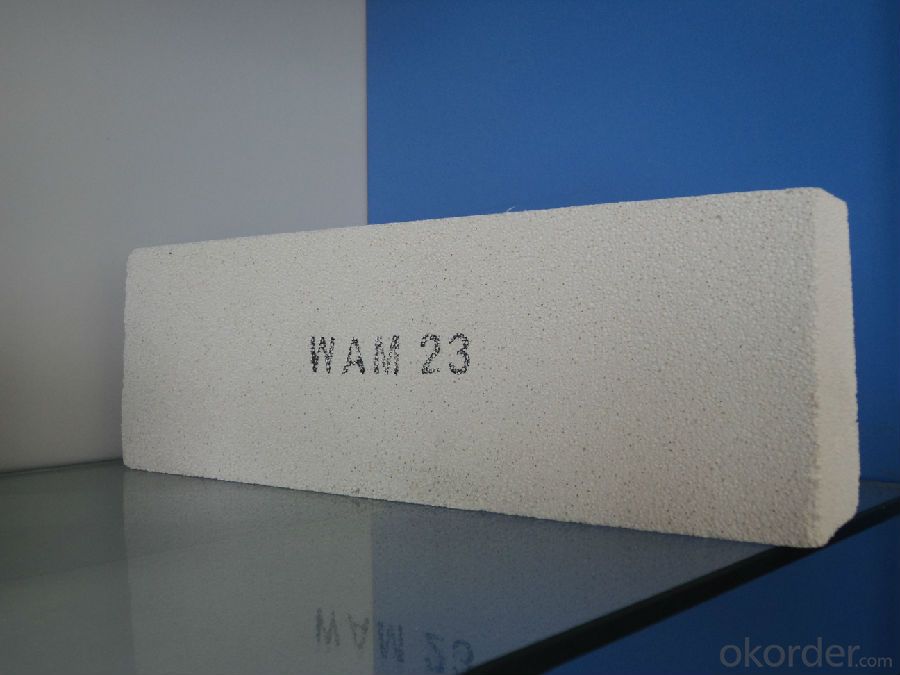
- Q: Are insulating fire bricks resistant to hydrogen sulfide?
- Insulating fire bricks are generally not resistant to hydrogen sulfide. Hydrogen sulfide is a highly corrosive gas that can react with many materials, including fire bricks. While fire bricks are designed to withstand high temperatures, they are not specifically designed to resist chemical corrosion. If exposed to hydrogen sulfide, fire bricks may deteriorate over time, leading to potential damage or failure. Therefore, it is recommended to use alternative materials that are specifically designed to resist hydrogen sulfide corrosion in applications where exposure to this gas is expected.
- Q: Are insulating fire bricks resistant to acid or alkali attacks?
- Insulating fire bricks are generally resistant to acid attacks, as they are made from materials such as alumina and silica, which have high resistance to acids. However, their resistance to alkali attacks may vary depending on the specific composition of the bricks and the concentration of the alkali solution. Some insulating fire bricks may exhibit good resistance to alkali attacks, while others may be more susceptible to degradation in the presence of alkali substances. It is important to consult the manufacturer or refer to the specific product specifications to determine the level of resistance to acid or alkali attacks for a particular type of insulating fire brick.
- Q: Can insulating fire bricks be used in the construction of BBQ pits?
- Yes, insulating fire bricks can be used in the construction of BBQ pits. These bricks are designed to withstand high temperatures and provide excellent insulation, making them ideal for creating a heat-resistant structure. They help to retain and distribute heat evenly, which is crucial for achieving optimal cooking conditions in a BBQ pit.
- Q: Are insulating fire bricks resistant to thermal spalling?
- Yes, insulating fire bricks are resistant to thermal spalling.
- Q: Can insulating fire bricks be used in the construction of heat exchangers?
- Yes, insulating fire bricks can be used in the construction of heat exchangers. These bricks are designed to withstand high temperatures and have excellent insulating properties, making them suitable for heat exchanger applications where heat retention and insulation are important.
- Q: Can insulating fire bricks be used in high-temperature ducts?
- Yes, insulating fire bricks can be used in high-temperature ducts. Insulating fire bricks are designed to withstand high temperatures and provide thermal insulation, making them suitable for use in ducts where high temperatures are present.
- Q: How do insulating fire bricks help reduce heat loss through convection?
- Insulating fire bricks have been specifically designed to minimize heat loss through convection, achieving this by establishing a barrier that obstructs the movement of air and heat transfer. Made from lightweight refractory materials with low thermal conductivity, these bricks are inadequate conductors of heat and do not easily permit heat to pass through them. Upon implementation in construction projects, these bricks establish an insulating layer that effectively diminishes heat transfer by convection. Convection, characterized as the process of heat transfer through the motion of air or fluid particles, is interrupted by the insulating fire bricks which function as a barrier, hindering the unrestricted flow of air and impeding convective currents. The bricks are engineered with small interconnected air pockets or pores that capture and trap air within them. These air pockets act as insulators, curtailing the convection-driven heat transfer. The trapped air forms a stagnant layer, restricting air movement and preventing heat from escaping or infiltrating the area. By reducing heat loss through convection, insulating fire bricks facilitate the maintenance of a stable and comfortable temperature within a structure. They are commonly employed in scenarios where heat insulation is imperative, such as industrial furnaces, kilns, and fireplaces. These bricks not only enhance energy efficiency by diminishing heat loss, but also contribute to fire safety by impeding the propagation of heat to adjacent areas.
- Q: Can insulating fire bricks be used in boilers for residential heating?
- Yes, insulating fire bricks can be used in boilers for residential heating. Insulating fire bricks are designed to withstand high temperatures and provide effective insulation, making them suitable for use in boilers to improve energy efficiency and heat retention.
- Q: Can insulating fire bricks be used in the construction of pottery kiln shelves?
- Yes, insulating fire bricks can be used in the construction of pottery kiln shelves. Insulating fire bricks are designed to withstand high temperatures and provide excellent insulation, making them an ideal material for kiln shelves. They can help maintain consistent heat distribution and prevent thermal shock, which is important for firing pottery. Additionally, insulating fire bricks are lightweight and easy to handle, making them a practical choice for constructing kiln shelves.
- Q: Can insulating fire bricks be used for kiln furniture?
- Yes, insulating fire bricks can be used for kiln furniture. Insulating fire bricks are designed to withstand high temperatures and are commonly used in industrial kilns and furnaces. They have excellent thermal insulation properties, which makes them ideal for creating kiln furniture such as shelves, posts, and supports. The insulating properties of these bricks help to distribute heat evenly throughout the kiln, ensuring that the items being fired are heated consistently. Additionally, insulating fire bricks are lightweight and easy to handle, making them a convenient choice for kiln furniture.
Send your message to us
Insulating Fire Brick - Refractory Insulating Fire Brick Code GJM23
- Loading Port:
- Shanghai
- Payment Terms:
- TT OR LC
- Min Order Qty:
- 10 m.t.
- Supply Capability:
- 30000 m.t./month
OKorder Service Pledge
OKorder Financial Service
Similar products
Hot products
Hot Searches
Related keywords
